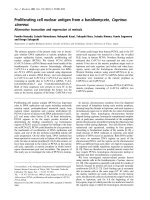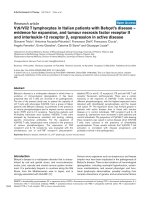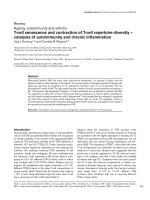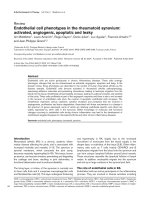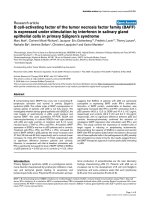Báo cáo y học: " Large cell non-Hodgkin’s lymphoma masquerading as renal carcinoma with inferior vena cava thrombosis: a case report" docx
Bạn đang xem bản rút gọn của tài liệu. Xem và tải ngay bản đầy đủ của tài liệu tại đây (1.09 MB, 5 trang )
CAS E REP O R T Open Access
Large cell non-Hodgkin’s lymphoma
masquerading as renal carcinoma with inferior
vena cava thrombosis: a case report
Erika E Samlowski
1
, Christopher Dechet
2
, Alan Weissman
1
and Wolfram E Samlowski
1,3*
Abstract
Introduction: Many cancers are associated with inferior vena cava (IVC) obstruction, but very few cancers have the
ability to propagate within the lumen of the renal vein or the IVC. Renal cell carcinoma is the most common of
these cancers. Renal cancer with IVC extension has a high rate of recurrence and a low five year survival rate.
Case presentation: A 62-year-old Caucasian woman previously in good health developed the sudden onset of
severe reflux symptoms and right-sided abdominal pain that radiated around the right flank. A subsequent
ultrasound and CT scan revealed a right upper pole renal mass with invasion of the right adrenal gland, liver, left
renal vein and IVC. This appeared to be consistent with stage III renal cancer with IVC extension. Metastatic
nodules were believed to be present in the right pericardial region; the superficial anterior abdominal wall; the left
perirenal, abdominal and pelvic regions; and the left adrenal gland. The pattern of these metastases, as well as the
invasion of the liver by the tumor, was thought to be atypical of renal cancer. A needle biopsy of a superficial
abdominal wall mass revealed a surprising finding: The malignant cells were diagnostic of large-cell, B-cell non-
Hodgkin’s lymphoma. The lymphoma responded dramatically to systemic chemotherapy, which avoided the need
for nephrectomy.
Conclusion: Lymphomas only rarely progress via intraluminal vascular extension. We have been able to identify
only one other case report of renal lymphoma with renal vein and IVC extension. While renal cancer would have
been treated with radical nephrectomy and tumor embolectomy, large-cell B-cell lymphomas are treated primarily
with chemotherapy, and nephrectomy would have been detrimental. It is important to remember that, rarely,
other types of cancer arise from the kidney which are not derived from the renal tubular epithelium. These may be
suspected if an atypical pattern of metastases or unusual invasion of surrounding organs is present. A preoperative
or intraoperative biopsy may be helpful in these cases.
Introduction
A number of malignancies are associated with inferior
vena cava (IVC) obstruction, but very few cancers exh i-
bit a potential for tumor thrombus formation and intra -
vascular extension within the lumen of the IVC. Re nal
cancer is the most common tumor associated with IVC
thrombosis [1,2]. More rarely, IVC extension has been
described in case reports of patients with adrenal cancer,
hepatoma, advanced testicular cancer, Wilms’ tumor,
colon cancer, gastric cancer, pancreatic cancer,
transiti onal cell carcinoma of the bladder and peripheral
neuroectodermal tumor [3,4].
The incidence of renal vein or IVC thrombosis in
patients with renal cancer appears to be 4% to 10% [5].
In the newly revised 2009 American Joint Committee
on Cancer staging system, tumor extension into the
renal vein or the vena cava is classifie d as stage T3a if
there is renal vein extension, as stage T3b if the tumor
extends into the subdiaphragmatic IVC and as stage T3c
if renal cancer extends above the diaphragm or invades
the endothelium of the IVC [6]. The extent of IVC
thrombus can also be sub-classified by the Mayo Clinic
system into level I (< 2 cm above the renal vein), stage
II (infrahepatic thrombus), stage III (intrahepatic IVC
* Correspondence:
1
Nevada Cancer Institute, One Breakthrough Way, Las Vegas, NV 89135, USA
Full list of author information is available at the end of the article
Samlowski et al. Journal of Medical Case Reports 2011, 5:245
/>JOURNAL OF MEDICAL
CASE REPORTS
© 2011 Samlowski et al; licensee BioMed Central Ltd. This is an Open Access ar ticle distributed under the terms of the C reative
Commons Attribution License ( which permits unrestricted use, dist ribution, and
reproduction in any medium, provided the original wor k is properly cited.
involvement below the diaphragm) and stage IV (above
the diaphragm or extending into the right atrium) [7].
The extent of tumor thrombus extension appears to
correlate closely wit h surgical outcome. If the tumor has
extended above the diaphragm, the chances for com-
plete surgical resection and consequently pa tient survi-
val are diminished [8]. Renal cancer with IVC extension
is generally treated with radical nephrectomy and tumor
embolectomy [2]. Renal cancer with renal vein or IVC
involvement remains associated with a high local and
distalfailurerate[6,9].AlOtabiet al. [8] d escribed a
64% recurrence rate in their 50-patient series, with a
50% five year survival rate. This failure rate is far greater
than that for stage T1 or T2 renal cancer (five year sur-
vival rates of 81% and 74%, respectively) [6]. A substan-
tial fraction of these patients (36% to 40%) present with
concomitant lymph node or distant metastatic disease at
the time IVC inv olvement is detected [5]. The extent to
which the tumor has physically invaded the renal vein
and the ven a cava endothelium (including intrahepatic
branches) also may be important to the patient’sprog-
nosis, although this is currently a subject of debate.
Primary renal non-Hodgkin’ slymphoma(NHL)is
thought to be rare, perhaps because of the lack of renal
lymphatic tissue [10,11]. There have been a few case
reports of intravascular extension of lymphomas. Rarely,
NHL can present with focal intravascular lymphoma
masses. This syndrome, termed intravascular large B-cell
lymphoma, is generally characterized by proliferation of
lymphoma cells in smaller blood vessels. In rare
patients, intravascular large B-cell lymphoma can pre-
sent as masses in large blood vessels. A single case of
intravascular large B-cell lymphoma that presented initi-
ally as superior vena cava syndrome has been reported
[12]. Rare additional case reports have described patients
who presented with superior vena cava thrombosis
which later revealed the presence of Burkitt’s lymphoma,
lymphoblastic NHL [13] and a primary cardiac B-cell
lymphoma that presented as superior vena cava syn-
drome [14].
Case presentation
A 62-year-old Caucasian woman who had previously
been in good health, except for a history of treated
hypothyroidism, presented to our hospital in November
2009 with sudden onset of severe reflux symptoms and
right-sided abdominal pain that radiated around the
right flank. An abdominal ultrasound examination was
performed. This revealed a large right-sided renal mass.
A subsequent computed tomographic (CT) scan con-
firmeda13cm×9cmrightupperpolerenalmass
with probable invasion of the right adrenal gland a nd
liver. Tumor extension into the left renal vein and the
IVC was also observed. This patient’ spresentation
corresponded to Mayo Clinic level III (Figures 1A and
1C). Her clinical presentation appea red to be consistent
with a large renal carcinoma with renal vein and IVC
extension. Metastatic nodules were b elieved to be pre-
sent in the right pericardial region; the anter ior abdom-
inal soft tissue left pelvis; the left perirenal, abdominal
and pelvic regions; and the left adrenal gland. This pat-
tern of metastasis seemed to be atypical of renal cell
carcinoma (RCC). Typical renal metastases are found in
the lung, periaortic lymph nodes or b one. This con-
trasted with the extensive intraabdominal spread seen in
our patient. In addition, direct tumor extension into the
liver is a rare finding in RCC. This tumor showed strong
fluorodeoxyglucose uptake on a subsequent positron
emission tomographic (PET) scan (Figure 2A). Upon
further questioning, the patient complained of ongoing,
Figure 1 Right renal mass and inferior vena cava (IVC)
thrombus. Renal mass and IVC thrombus. (A) Computed
tomographic (CT) image showing large renal mass (open white
arrows) invading right adrenal gland, liver and IVC. Note
intravascular thrombus in the IVC (solid white arrows). (B) CT image
showing marked improvement in renal mass after three cycles of
cyclophosphamide, doxorubicin, vincristine, prednisone plus
rituxumab (R-CHOP) chemotherapy (open arrows). (C) CT image
showing normal left renal vein (black solid arrow), but the right
renal vein is not seen (black open arrows), consistent with occlusion
by malignant thrombus. White arrows identify the renal tumor. (D)
CT image shows improvement of right renal mass.
Samlowski et al. Journal of Medical Case Reports 2011, 5:245
/>Page 2 of 5
mild right flank discomfort, chronic fatigue and rare
sweats, but no weight loss or chills. Her physical exami-
nation did not reveal a palpable abdominal mass. Base-
line complete blood count and blood chemistry testing
(including liver and kidney function) were normal,
except for an elevated lactate dehydrogenase level of
340IU/L (normal range, 120 to 250IU/L). Because the
patient had a superficial abdominal wall mass (Figure
3A), a needle biopsy was performed to aid in surgical
treatment planning. The cytology and core biopsy from
this specimen reve aled a surprising finding: The malig-
nant cells were thought to represent large-cell, B-cell
NHL. This was confirmed by flow cytometry, which
identified a light chain restricted B-cell population
that expressed CD19 and CD20. The patient is currently
undergoing cyclophosphamide, doxorubicin, vincristine,
prednisone plus rituxumab (R-CHOP) chemotherapy. R-
CHOP treatment currently represents the most effective
chemotherapy regimen for large-cell NHL in patients
over 60 years of age [15]. This regimen was well toler-
ated, and upon reimaging with PET and CT scans after
three cycles of chemotherapy, she showed an objective
partial response in tumor dime nsions (Figures 1B and
1D) with markedly decreased fluorodeoxyglucose uptake
(Figure 2B). The anterior abdominal subcutaneous mass
also demonstrated a nearly complete response after
three cycles of R-CHOP chemotherapy (Figure 3B).
Discussion
Tumor thrombi in major venous structures can occur as
a complication of cancer. Approximately 90% of all
cases of superior vena cava syn drome are caused by
compression of the superior vena cava by an extrinsic
tumor. Most commonly, this is a complication of lung
cancer (especially small-cell lung cancer), but it can also
be caused by lymphomas, as well as by b reast, esopha-
geal, thyroid, thymus and testicular cancer. A very small
percentage of cases of superior vena cava syndrome are
associated with actual intravascular tumor invasion and
extension. Obstruction of the IVC is even less common
[3,4]. Extrinsic compression of the IVC by tumors such
as testicular cancer, lymphoma, pancreatic cancer,
Wilms’ tumor and sarcoma may occur, but these are
relatively rare events associated with advanced cancer.
Intravascular extension and tumor thrombi are most
commonly seen in patients with RCC, occurring in 4%
to 10% of RCC cases [5]. IVC tumor thrombi can also
be caused by adrenal cortical carcinomas and hepatomas
and much less frequently by other tumor types [3,4].
The current case is quite unusual. The large re nal
mass seen on the radiographs of the right kidney was
thought to represent RCC, with invas ion into the right
adrenal gland and liver and extension into the renal vein
and the IVC on the basis of PET and CT scan abnorm-
alities not verified by an additional biopsy. Direct exten-
sion of RCC into the liver is also thought to be
uncommon [16]. A pre-treatment biopsy identified the
tumor in our patient to be large-cell, B-cell NHL. Lym-
phomas very rarely progress via intraluminal vascular
extension. We have been able to identify only one other
case report of renal vein and IVC extension of a renal
lymphoma. That case report, published by Wagner et al.
[17], described another patient with large-cell, B-cell
NHL mimicking stage III renal adenocarcinoma with
tumor thrombi in the renal vein and IVC.
Figure 2 Positron emission tomographic (PET) scan uptake in
renal mass and abdominal metastasis. Axial PET image. (A)
Intense fluorodeoxyglucose activity is seen in right renal mass
(white arrows). Contralateral abdominal disease is also identified
(black open arrows). (B) Axial PET image showing absent
fluorodeoxyglucose activity in right renal mass after three cycles of
chemotherapy.
Figure 3 Anterior abdominal subcutaneous tumor.
Subcutaneous abdominal mass (source of diagnostic biopsy). (A)
Subcutaneous mass at initial diagnosis (white arrows). (B) Marked
reduction in subcutaneous mass following three cycles of
chemotherapy (white arrows). The CT scan slices are aligned to
show the maximum dimensions of the soft tissue tumor mass.
Samlowski et al. Journal of Medical Case Reports 2011, 5:245
/>Page 3 of 5
Conclusion
The presence of a renal mass with a tumor extending
into the renal vein and IVC is most frequently a mani-
festation of clear-cell RCC. It should be remembered
that other non-renal tubular epithelium-derived cancers
occasionally arise from t he kidney. Our case report
represents the second published instance of a renal lym-
phoma. Intravascular extension of lymphoma is a rare
clinical finding. An atypical pattern o f intra-abdominal
spread of metastases and liver invasion was an impor-
tant clue that this was potentially not a RCC. When fea-
sible, a pre-treatment (or intraoperative) biopsy may be
helpful in planning appropriate management strategies.
While the management of RCC with IVC thrombosis
may include radical nephrectomy and tumor embolect-
omy, this is a difficult operation with significant morbid-
ity and mortality. In contrast, large-cell lymphomas are
treated primarily with chemotherapy, such as the cur-
rent R-CHOP regimen combined with the CD20 mono-
clonal antibody rituximab (R-CHOP). This regimen
results i n a very high response rate, as seen in our
patient, and 50% to 70% durable complete remission
rates (with five-year to ten-year follow-up). A nephrect-
omy would be unhelpful in treating renal lymphoma. In
our opinion, features that would increase suspicion for
non-RCC would be extensive effacement of adjacent
organs by tumor masses and atypical patterns of
metastases.
Patient’s perspective
The occurrence of pain hit quickly right after my indul-
gence at Thanksgiving dinner. I thought I had reflux
from over-eating of rich foods. The pain traveled from
the abdomen around to the back and up into and under
my right shoulder blade. I was uncomfortable in all
positions, whether standing, sitting or lying down. A
handful of Tums for several days did not do the trick,
and I went to see my physician. A battery of tests was
ordered to determine what was happening. During the
course of the tests, nodules started popping up in my
abdomen, close to the surface. My pain had intensified
throughout the abdomen and into the back to the point
where I could not stand for any longer than a few min-
utes without doubling over.
After the ultrasound results came back, it was noted
that a “suspicious spot” was seen on my kidney, and
subsequent blood work and a CT scan suggested that I
had renal cancer. I sought the assistance of the Nevada
Cancer Institute for the diagnosis of renal cancer. I had
a biopsy, which resulted in the discovery that I had non-
Hodgkin’ s lymphoma. Once the chemotherapy treat-
ments started, my pain subsided along with the nodules,
during the second treatment. I have had very mild if any
side effects during the chemo. I ba se this on my prior
good health, strong will, positive attitude, a great sup-
port team and making sure I stay extremely hydrated
during the treatments. I have remained active and work-
ing and have had as little disruption to my life as possi-
ble. Presently I am feeling very good, have had excellent
results from the PET scan after the third chemotherapy,
and am awaiting the results of my next scan after the
sixth treatment.
Consent
Written informed consent was obtained from the patient
for publication of this case report and a ny accompany-
ing images. A copy of the written consent is available
for review by the Editor-in-Chief of this journal.
Abbreviations
IVC: Inferior Vena Cava; NHL: Non-Hodgkin’s Lymphoma; PET: Positron
Emission Tomography.
Author details
1
Nevada Cancer Institute, One Breakthrough Way, Las Vegas, NV 89135, USA.
2
Huntsman Cancer Institute, 2000 Circle of Hope Drive, Salt Lake City, UT
84148, USA.
3
2435 Grassy Spring Pl, Las Vegas NV 89135, USA.
Authors’ contributions
ES performed the literature search and wrote the case report. AW
interpreted the radiographs and provided publication-quality images. CD
provided expert input on urologic management of renal vein thrombosis
and renal cancer. WES helped write the manuscript and formatted the
document according to JMCR standards. All authors helped edit the final
manuscript and approved its submission.
Competing interests
The authors declare that they have no competing interests.
Received: 2 May 2010 Accepted: 28 June 2011 Published: 28 June 2011
References
1. Didier D, Racle A, Etievent JP, Weill F: Tumor thrombus of the inferior
vena cava secondary to malignant abdominal neoplasms: US and CT
evaluation. Radiology 1987, 162:83-89.
2. Shuch B, Larochelle JC, Onyia T, Vallera C, Margulis D, Pantuck AJ, Smith RB,
Belldegrun AS: Intraoperative thrombus embolization during
nephrectomy and tumor thrombectomy: critical analysis of the
University of California-Los Angeles experience. J Urol 2009, 181:492-499.
3. Yamana D, Yanagi T, Nanbu I, Tanaka K, Hirabayashi S, Tohyama J,
Mizutani H, Ohba S, Katoh N, Ono Y: Intracaval invasion of left adrenal
cortical carcinoma extending into the right atrium. Radiat Med 1997,
15:327-330.
4. Zeng ZC, Fan J, Tang ZY, Zhou J, Wang JH, Wang BL, Guo W: Prognostic
factors for patients with hepatocellular carcinoma with macroscopic
portal vein or inferior vena cava tumor thrombi receiving external-beam
radiation therapy. Cancer Sci 2008, 99:2510-2517.
5. Lambert EH, Pierorazio PM, Shabsigh A, Olsson CA, Benson MC,
McKiernan JM: Prognostic risk stratification and clinical outcomes in
patients undergoing surgical treatment for renal cell carcinoma with
vascular tumor thrombus. Urology 2007, 69:1054-1058.
6. Edge SB, Byrd DR, Compton CC, Fritz AG, Greene FL, Trotti AI, Eds: Cancer
Staging Manual. 7 edition. New York: Springer; 2010.
7. Boorjian SA, Sengupta S, Blute ML: Renal cell carcinoma: vena caval
involvement. BJU Int 2007, 99:1239-1244.
8. Al Otaibi M, Abou Youssif T, Alkhaldi A, Sircar K, Kassouf W, Aprikian A,
Mulder D, Tanguay S: Renal cell carcinoma with inferior vena caval
Samlowski et al. Journal of Medical Case Reports 2011, 5:245
/>Page 4 of 5
extention: impact of tumour extent on surgical outcome. BJU Int 2009,
104:1467-1470.
9. Klatte T, Pantuck AJ, Riggs SB, Kleid MD, Shuch B, Zomorodian N,
Kabbinavar FF, Belldegrun AS: Prognostic factors for renal cell carcinoma
with tumor thrombus extension. J Urol 2007, 178:1189-1195.
10. Gellrich J, Hakenberg OW, Naumann R, Manseck A, Lossnitzer A, Wirth MP:
Primary renal non-Hodgkin’s lymphoma: a difficult differential diagnosis.
Onkologie 2002, 25:273-277.
11. Okuno SH, Hoyer JD, Ristow K, Witzig TE: Primary renal non-Hodgkin’s
lymphoma: an unusual extranodal site. Cancer 1995, 75:2258-2261.
12. Savarese DM, Zavarin M, Smyczynski MS, Rohrer MJ, Hutzler MJ: Superior
vena cava syndrome secondary to an angiotropic large cell lymphoma.
Cancer 2000, 89:2515-2520.
13. Juimo AG, Temdemno AM, Tapko JB, Yomi J, Teyang A, Tagny G,
Tchokoteu PF, Lysinge A, Pagbe JJ, Mbakop A: Superior vena cava tumoral
thrombosis revealing a Burkitt’ s lymphoma and a lymphoblastic non-
Hodgkin’s lymphoma: a case report. Angiology 1997, 48:263-268.
14. Koumallos N, Antoniades C, Antonopoulos AS, Tousoulis D, Androulakis A,
Psarros T, Stefanadis C: A rare case of primary cardiac lymphoma
presented as superior vena cava syndrome. J Am Coll Cardiol 2009,
54:368.
15. Coiffier B, Lepage E, Briere J, Herbrecht R, Tilly H, Bouabdallah R, Morel P,
Van Den Neste E, Salles G, Gaulard P, Reyes F, Lederlin P, Gisselbrecht C:
CHOP chemotherapy plus rituximab compared with CHOP alone in
elderly patients with diffuse large-B-cell lymphoma. N Engl J Med 2002,
346:235-242.
16. Karellas ME, Jang TL, Kagiwada MA, Kinnaman MD, Jarnagin WR, Russo P:
Advanced-stage renal cell carcinoma treated by radical nephrectomy
and adjacent organ or structure resection. BJU Int 2009, 103:160-164.
17. Wagner JR, Honig SC, Siroky MB: Non-Hodgkin’s lymphoma can mimic
renal adenocarcinoma with inferior vena caval involvement. Urology
1993, 42:720-724.
doi:10.1186/1752-1947-5-245
Cite this article as: Samlowski et al.: Large cell non-Hodgkin’s lymphoma
masquerading as renal carcinoma with inferior vena cava thrombosis: a
case report. Journal of Medical Case Reports 2011 5:245.
Submit your next manuscript to BioMed Central
and take full advantage of:
• Convenient online submission
• Thorough peer review
• No space constraints or color figure charges
• Immediate publication on acceptance
• Inclusion in PubMed, CAS, Scopus and Google Scholar
• Research which is freely available for redistribution
Submit your manuscript at
www.biomedcentral.com/submit
Samlowski et al. Journal of Medical Case Reports 2011, 5:245
/>Page 5 of 5
